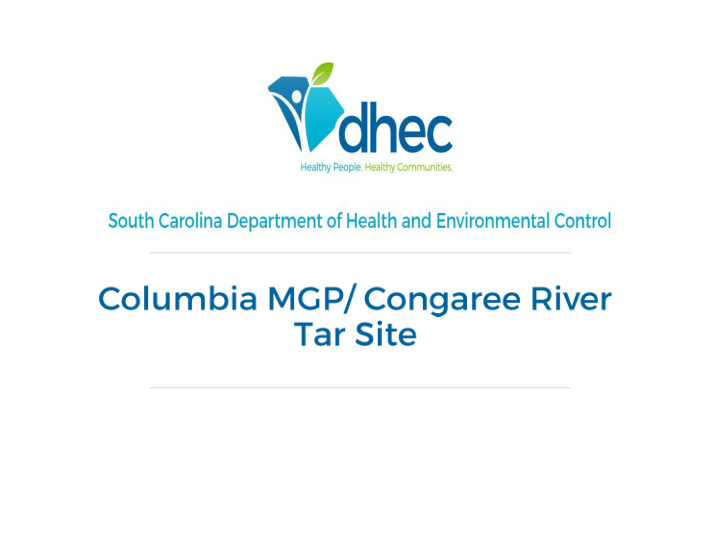



• Brief History • Update progress since the last public meeting Mar. 21, 2013 • Discuss issues with Removal Action • Discuss cleanup alternatives • Discuss path forward
• SCE&G – The Responsible Party (RP) for the Tar-Like Material (TLM) in the Congaree River • DHEC – Responsible for overseeing the actions of the RP to address the TLM • US Army Corps of Engineers – Responsible for reviewing a proposed activity by the RP to determine if a permit can be issued Under the Clean Water Act or the Rivers and Harbors Act
• Tar like material (TLM) in the Congaree River was reported in June 2010 by a citizen complaint • DHEC responded by posting no swimming signs, collecting samples and looking for a source • The source was determined to originate from a former Manufactured Gas Plant located on Huger St.
1937
• The primary potential risk is from direct contact with the TLM • Undisturbed, the TLM is not dissolving into the river water and poses little risk to the water quality. This is based on water sampling results as well as the fact TLM is still present 60 to 100 years after it entered the river environment.
• Environmental Evaluation / Cost Analysis, January 2013 • March 21, 2013 Public Meeting held on 4 alternatives. Public comment was invited. • Goal is to find a solution that is protective of Human Health and the Environment and that is implementable.
• Alternative 4 – Removal of the Impacted Sediment with Off-Site Disposal • Construction of series of temporary dams so the TLM could be removed under dry conditions.
• October 2013, SCE&G began the design and started the permitting process with the US Army Corps of Engineers for construction of a cofferdam • Scale of the rock-based cofferdam: • 19 feet high • 60 feet wide at the base • Covering a total river bed area 300 ft. x 2000 ft.
• Risk of increased erosion to the shoreline on the west bank; • Risk of flooding along the west bank; • Risk of overtopping of the cofferdam; • Risk of catastrophic overtopping where cofferdam material and exposed Tar material would be washed downriver; • Concerns that the cofferdam could not be adequately removed when done
• The large-scale cofferdam approach had to be re-evaluated • Cofferdam could not meet the Army Corps of Engineers’ permit requirements • Pursue Alternative Approach to TLM Removal
In January 2015, SCE&G proposed a smaller- scale design using large sandbags instead of rocks. Through the summer of 2015 this design was developed. This design would involve isolating a smaller riverbed area to be worked on (up to 200 ft. by 900 ft.) The bags would be moved around as areas were completed.
• Army Corps and DHEC agreed to field demonstration project which began on September 29, 2015 • On October 4, 2015 the historic flood event occurred. • The Columbia Canal failed just upriver depositing up to 5 feet of new sediments over areas planned for TLM excavation
• Sandbags were also found not to be adequate in restricting river flow • Infiltrations under bags and around bags was a problem • Limitations on height of this structure was inadequate to deal with dynamic river conditions
• Sandbags will not allow for excavation in the dry and is not an adequate solution • Removal is not a viable alternative for cleanup • SCE&G requested DHEC to consider the capping and institutional controls alternative • DHEC requested SCE&G to determine if capping will meet the Army Corps of Engineers permitting requirements
• Awaiting decision by the Army Corps • DHEC will hold another public meeting to present the new preferred alternative once a decision is made with a public comment period on the alternative
Recommend
More recommend